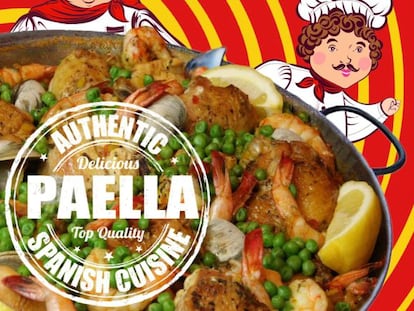A tour of 15 Spanish cities through their most typical dishes
From hearty stews to refreshing soups, here is what to look for and where to eat it
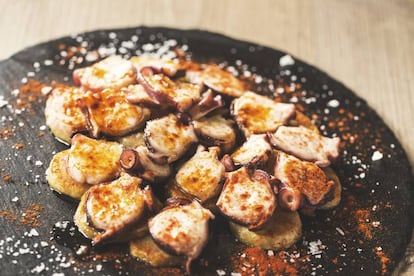
There are cities in Spain whose names are inextricably associated with a certain dish. Each culinary creation is made following centuries-old recipes, and some even have their own calendar day.
Migas in Teruel
Migas, a simple but hearty dish that literally means “crumbs,” is the choice of reference in the Aragonese city of Teruel, where winters can be freezing cold. A loaf of bread is crumbled and left to soak overnight in water and salt. It is then fried with garlic in very hot olive oil, stirring constantly to prevent the mix from sticking to the bottom of the pan. Cubed ham, chorizo, bacon and grapes are added to the mix, with the latter ingredient contributing a touch of freshness to this satiating concoction. Some people hold that Teruel’s migas go all the way back to the 16th-century hormigos, made with bread and wheat. For a tasty sampling of modern migas try La Barrica (c/ Abadía, 5), a classic stop in the local tapas scene.
Trigo in Almería
There is a typical dish in the inner areas of Almería that takes a long time to prepare but can still be found at traditional bars and restaurants: trigo, or wheat. It is a good example of subsistence cuisine, using available ingredients provided by the land and the chicken coop. Wheat seeds take the place of rice as the main element in this dish, because in the old days rice had to be bought, while wheat was grown locally to make bread. Same with the fennel used to give the dish its particular touch, and which grows in any cultivated field. Supermarkets in Almería sell wheat seeds for anyone wishing to try it at home, but another option is to swing by El quinto toro or Taberna de Nuestra Tierra, both in the city of Almería.
Salmorejo in Córdoba
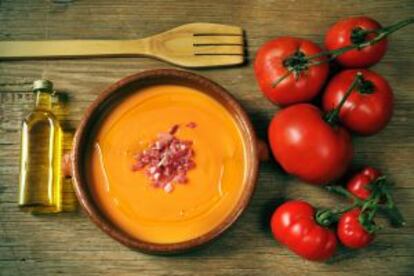
In 2008, an association called Cofradía Gastronómica Salmorejo Cordobés was created to promote research into this classic Andalusian dish – and, by extension, to boost tourism in the province. This cousin of the gazpacho even has its own calendar date, April 24, which is Córdoba Salmorejo Day. The recipe can be found on the association’s website, in 52 languages. There is even a special version for people with gluten intolerance. A classic salmorejo uses nothing more than ripe tomatoes, pan de telera (a local bread), extra virgin olive oil, a clove of Montalbán garlic and a pinch of salt; the resulting cream is decorated with bits of jamón and hard-boiled egg. For an entire menu’s worth of salmorejo varieties, try La Salmoreteca inside Mercado Victoria, run by the chef Juanjo Ruiz.
Txangurro in San Sebastián
Txangurro is the Basque name for the spider crab, which is stuffed and cooked au gratin, then served in its own shell. It is a specialty of San Sebastián, where people have it on special occasions such as Christmas, often as a first course. The city boasts 16 Michelin stars within a 25-kilometer radius, and much of its cuisine is derived from the sea. Saltxipi, located near the beach in the Gros district of town, has made txangurro one of the star dishes on its menu. And Bar Ganbara, a classic eatery in the old quarter, serves txangurro tartlets as a tapa – or pintxo, as the bite-size dishes are called in the Basque Country.
Callos in Madrid
Back in the 19th century, the legendary Madrid establishment Lhardy was already serving callos, possibly one of the most representative dishes of the Spanish capital. The stew is served in an earthenware dish and includes beef tripe, blood sausage, Serrano ham, chorizo, onion, carrot, leek, garlic and/or hot peppers. Some theories claim that it was migrants from the northern region of Asturias who originally brought callos to Madrid.
Paella in Valencia
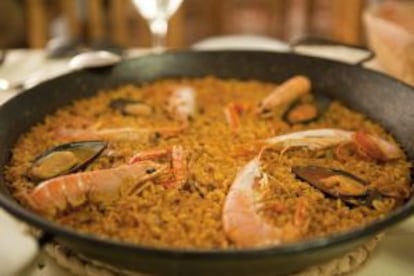
In Valencia, a paella is technically the pan that the rice is cooked in, although the name now extends to the dish itself. Shepherds and farmers began making it between the 15th and 16th centuries using local ingredients: rice, chicken, rabbit, green beans, garrofó (a type of large white bean typical to this area), tomato, olive oil, water, saffron and salt. Depending on the location, other ingredients may be added. The orthodox method requires open-air cooking over a firewood stove, preferably using orange tree wood. L’Alter in Picassent rose to fame after The New York Times pronounced its paellas among the best in the world. A hint: try Arrocería Duna, on El Saler beach, inside L’Albufera Natural Park.
Cocido maragato in Astorga (León)
This is a typical dish in the Maragatería, an area of León province that was once home to the Maragato people, a distinct social group with their own traditions. This stew is notable in that it is served “backwards” from other Spanish stews: first come the seven varieties of meat, then the vegetables (cabbage), and finally the soup and chickpeas.
Legends abound regarding the origin of this inverse order. One claims that during the War of Independence, the French army decided to start with the meat in case they were called to battle before the end of lunch. But it’s more likely that the origin lies in the fact that Maragato mule drivers used to eat the meat on the road, then ask for soup when they made rest stops at roadside inns. Two good places to enjoy a real cocido maragato are Casa Maruja (Calle Real, 24) or Hostería Casca Coscolo in Castrillo de los Polvazares. Another is is Las Termas in Astorga.
Piquillo peppers in Lodosa (Navarre)
Lodosa, a village in Navarre some 70 kilometers from Pamplona, is home to the famous red peppers known as pimientos del piquillo. Moderate in size and triangular in shape, they are often served stuffed. A good place to sample them is Asador Los Nandos.
Fabada in Villaviciosa (Asturias)
Villaviciosa has been celebrating a fair around its famous fabes (beans) for the last 23 years. Since 2011, local authorities and a food company named Gustatio have organized a competition called La mejor fabada del mundo (The best fabada in the world), which attracts restaurants from across the Spanish geography in a bid to come up with the most praiseworthy version of this prized dish from Asturias. The last edition was won by Vista Alegre, in Colunga. Another good place for fabada is El Verano (Lugar Cabriton, 3), in Argüero.
Wrinkled potatoes in Tenerife
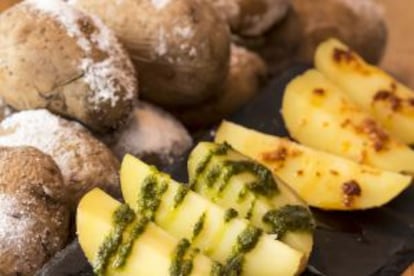
Most of the old varieties of Canary Island potato are to be found on Tenerife. Whether melonera or borralla, bonita or marrueca, they are all small and remarkably tasty. To wrinkle them, chefs cook them unpeeled in a pot of salty water, then dry them over a fire with extra salt. The hot sauce known as mojo picón (from the Portuguese word molho, for sauce) is made with a dry red pepper called pimienta palmera or picona. A good option for a sampling of papas is El Arcon Tapas (Plaza Concejil, 2), in Puerto de la Cruz.
Snails in Linares (Jaén)
Snail season gets underway in the spring, heralding the arrival of good weather. In Linares they are served in a hot broth that features cayenne pepper or guindilla), with a touch of mint. This dish is also typical to the neighboring cities of Úbeda and Baeza, and of the entire province of Jaén in general, where residents are great fans of the mollusk. Three places to try them in Linares: Los Mejillones ( Calle la Virgen, 16), Espronceda and Bar Marcelino (Espronceda, 17).
Carcamusas in Toledo
One of the most emblematic dishes in Toledo – which is this year’s Spanish Gastronomy Capital – is carcamusas: pork loin coooked in a slightly hot sauce with tomatoes and green peas. Some people believe that the word carcamusa comes from camush, which in Romance languages means “wrinkled,” as in wrinkled meat. Another theory holds that a bar owner named José Ludeña created a dish that pleased both kinds of clients at his establishment: the carcas, or old geezers, and the young ladies whom the former saw as their musas (muses).
Escalivada in Barcelona
This salad owes its name to the Catalan verb escalivar, which means to roast in hot ashes. And that is what they do with the onion, tomato, pepper and eggplant that go into this dish. It is often offered on a toast of Catalan bread known as pan payés, which has a harder crust than the average bread. Anchovy fillets are served on the side. Escalivada is eaten at room temperature, ideally in the spring or summer. Good ones are made at the food stands inside Santa Caterina Market, and at L'Actiu, a restaurant run by Barcelona Activa, a municipal agency aimed at promoting entrepreneurship.
Pulpo a feira in O Carballiño (Ourense)

There is no event or festivity in Galicia that does not include octopus being cooked in large copper pots. Curiously enough, the only Galician province without a coastline, Ourense, has the best reputation for octopus dishes. This tradition goes back to the monastery of Oseira, which accepted the cephalopods as payment in kind when it went around collecting the tithe on the coast of Pontevedra. The Festa do Pulpo is held the second Sunday of August. The classic Galician octopus dish is served on a round wooden board, and sprinkled with olive oil, sea salt and paprika. A traditional eatery in O Carballiño is Casa Gazpara (Rúa das Flores, 2); another one is Pulpería Fuchela (Avenida 25 Xullo, 48).
Suckling lamb in Aranda de Duero (Burgos)
Aranda de Duero, in Burgos province, is one of the top places to taste a dish that is widely popular across Castilla y León. The tender meat is prepared inside a wood oven and served piping hot; the skin should be crispy enough to crack when sliced. The best drink to wash it down is a Ribera del Duero red. In Aranda, diners will not be disappointed at El Lagar de Isilla, Mesón El Pastor or Casa Florencio.
English version by Susana Urra.
Tu suscripción se está usando en otro dispositivo
¿Quieres añadir otro usuario a tu suscripción?
Si continúas leyendo en este dispositivo, no se podrá leer en el otro.
FlechaTu suscripción se está usando en otro dispositivo y solo puedes acceder a EL PAÍS desde un dispositivo a la vez.
Si quieres compartir tu cuenta, cambia tu suscripción a la modalidad Premium, así podrás añadir otro usuario. Cada uno accederá con su propia cuenta de email, lo que os permitirá personalizar vuestra experiencia en EL PAÍS.
¿Tienes una suscripción de empresa? Accede aquí para contratar más cuentas.
En el caso de no saber quién está usando tu cuenta, te recomendamos cambiar tu contraseña aquí.
Si decides continuar compartiendo tu cuenta, este mensaje se mostrará en tu dispositivo y en el de la otra persona que está usando tu cuenta de forma indefinida, afectando a tu experiencia de lectura. Puedes consultar aquí los términos y condiciones de la suscripción digital.
More information
Archived In
Últimas noticias
The complicated life of Francesca Albanese: A rising figure in Italy but barred from every bank by Trump’s sanctions
How Japan is trying to avert ‘digital defeat’
Half of Scotland is in the hands of 420 property owners
From digital curfews to blocking apps: How technology experts protect their children online
Most viewed
- Why we lost the habit of sleeping in two segments and how that changed our sense of time
- Pablo Escobar’s hippos: A serious environmental problem, 40 years on
- Trump’s obsession with putting his name on everything is unprecedented in the United States
- The Florida Keys tourist paradise is besieged by immigration agents: ‘We’ve never seen anything like this’
- Charles Dubouloz, mountaineering star, retires at 36 with a farewell tour inspired by Walter Bonatti

